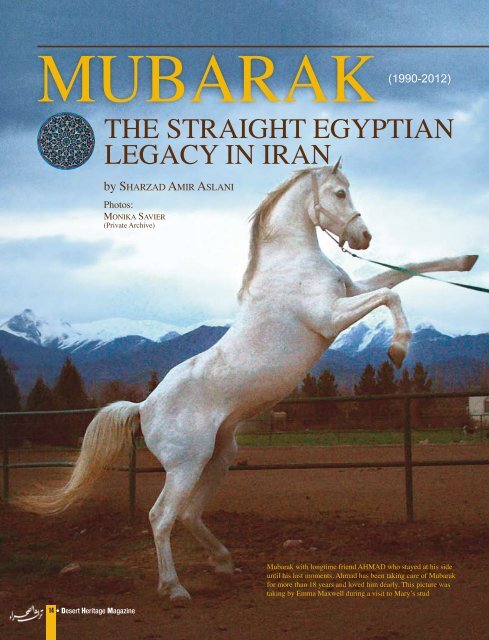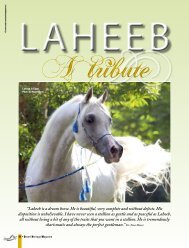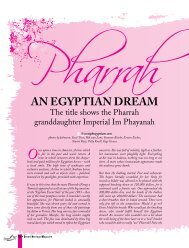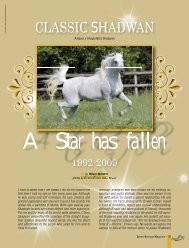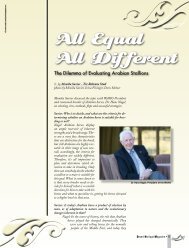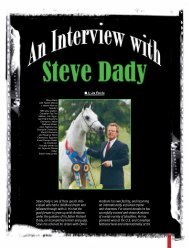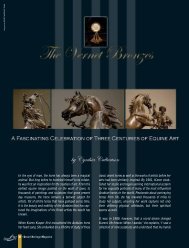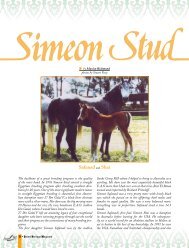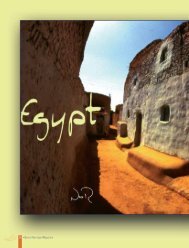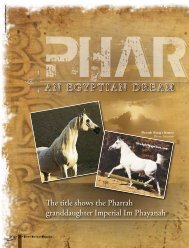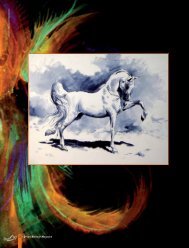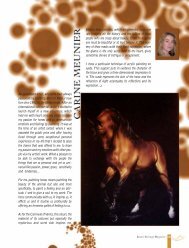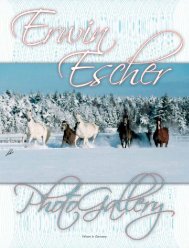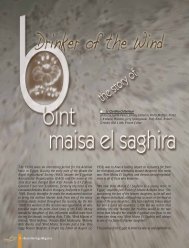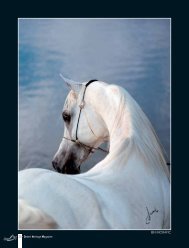Mubarak - Desertheritagemagazine.com desert heritage magazine
Mubarak - Desertheritagemagazine.com desert heritage magazine
Mubarak - Desertheritagemagazine.com desert heritage magazine
You also want an ePaper? Increase the reach of your titles
YUMPU automatically turns print PDFs into web optimized ePapers that Google loves.
MUBARAK (1990-2012)<br />
THE STRAIGHT EGYPTIAN<br />
LEGACY IN IRAN<br />
by SHARZAD AMIR ASLANI<br />
Photos:<br />
MONIKA SAVIER<br />
(Private Archive)<br />
14<br />
• Desert Heritage Magazine<br />
<strong>Mubarak</strong> with longtime friend AHMAD who stayed at his side<br />
until his last moments. Ahmad has been taking care of <strong>Mubarak</strong><br />
for more than 18 years and loved him dearly. This picture was<br />
taking by Emma Maxwell during a visit to Mary’s stud
SHARZAD AMIR ASLANI has been<br />
breeding horses for more than 24<br />
years and since her first purchase,<br />
she has been driven to racing. She<br />
has been breeding and training<br />
race champions with a little weakness<br />
toward Egyptian lines although<br />
she has also successfully<br />
used French bloodlines.<br />
ew months ago, when I decided to write this article <strong>Mubarak</strong><br />
was still alive but there were rumors that he was<br />
suffering from heart disease. Unfortunately, not much has<br />
been said to the unbelievable influence this stallion has had in<br />
Iranian breeding and with the following article my goal was for<br />
the world to appreciate his bearing in our country.<br />
Now, that he has passed away and is grazing in greener pastures,<br />
hopefully reunited with the lady he was so attached to, I would<br />
like to share his story with all horse lovers of the world.<br />
Strains have always been very important for an Iranian breeder and<br />
usually when referring to a particular horse, the first question ever<br />
asked is “which strain does it belong to?” So, when Mary Gharagozlou,<br />
the Asil horse Lady of Iran decided to import a stallion from<br />
abroad, it was without saying that it should have a well-known strain<br />
and a very strong mother line.<br />
Mary’s long time friend, Dr. Hans Nagel proposed to her a promising<br />
young colt, sired by Salaa-e-dinn out of Myrna, an Egyptian<br />
Prince daughter.<br />
I think, every breeding has a reason and a purpose and we should<br />
leave it to Dr. Hans Nagel himself to tell us in his own words about<br />
how <strong>Mubarak</strong> came to the world and how it found its way to Iran.<br />
“<strong>Mubarak</strong>’s dam Myrna was a mare which I was looking for a long<br />
time. I could not find a member of the Moniet el Nefous-family in<br />
Egypt with the kind of breeding I liked. She should originate from<br />
this Moniet el Nefous-family, one of the best foundation stock in El<br />
Zahraa, but in a certain <strong>com</strong>bination. This Moniet el Nefous had a<br />
daughter called Bint Moniet el Nefous by Nazeer, she was sold to<br />
America and it was my intention to try to find an offspring there.<br />
Mary, <strong>Mubarak</strong> and Chiquita the German Shepard Mary hand raised since birth.<br />
The picture was taken 2 month prior Mary passed away in 2002. She did not like<br />
to pose for pictures and it was after heavy insistence that she reluctantly agreed<br />
to stand with <strong>Mubarak</strong>.<br />
Desert Heritage Magazine • 15
<strong>Mubarak</strong> arrived in his new home in Iran!<br />
Photo by Sharzad Amir Aslani<br />
Bentwood Farms in Texas collected this stock and finally<br />
I was able to get Myrna as a 1 ½ year old filly. I had to<br />
give another one of my mares away in exchange which<br />
Bentwood liked; she was from the Dahman Shawan family.<br />
Otherwise they would not have parted with Myrna.<br />
Myrna’s sire was The Egyptian Prince, a perfect <strong>com</strong>bination,<br />
since The Egyptian Prince was by Morafic, a<br />
grandson of Moniet el Nefous out of Bint Mona. She was<br />
the dam of The Egyptian Prince and as well a granddaughter<br />
of Moniet el Nefous. Like this, I had a very strong<br />
<strong>com</strong>bination on that beautiful old Egyptian mare.<br />
<strong>Mubarak</strong> was the first foal from a breeding with Salaa el<br />
Dine. Myrna had other foals before, but this one made me<br />
more than happy. This little colt was quite elegant, had a<br />
much wider scope in all his body features: A longer neck,<br />
higher on his legs and a very nice head. He grew up in<br />
that year with five other foals and I noticed something<br />
special with this horse: He was ambitious and fast. In our<br />
stud we have a very suitable facility to observe such abilities:<br />
When our Arabians are leaving their stables, they<br />
have to run first on a sandy runway of 6 m width and<br />
about 300 m length until they arrive at their pasture<br />
16<br />
• Desert Heritage Magazine<br />
<strong>Mubarak</strong> being playful in his paddock<br />
which is as well 300 m long and 200 m wide. This is every<br />
morning a wonderful spectacle. One can see them running<br />
into their liberty, following each other for about 500<br />
m, then they make a turn on the pasture, run another<br />
cycle, and then they finally relax. This little colt always<br />
wanted to be the first – and he was.<br />
One day I received a telephone call from Düsseldorf,<br />
and on the other side was Mary. She was there to load<br />
a few young colts which were sent to Düsseldorf from a<br />
friend of hers from Spain. She had not seen these horses<br />
in person but only on pictures. She had all reasons to<br />
trust this breeder. Apparently Mary had still a different<br />
idea about what she wanted as an Egyptian horse. She<br />
had visited my farm just a few years ago and she remembered<br />
well what type of horses I was breeding. Consequently<br />
she asked me : “Have you a little colt for me<br />
which I could take to Teheran? I need one of your type,<br />
but he must be strong and everything has to go very<br />
quickly, since our plane is leaving tomorrow; I wish to<br />
take him with me. Please agree that all the rest we settle<br />
later.” I told Mary that I would call her back in one hour<br />
and I would see. Definitely I was one of the great ad-
mirers of Mary, since I have known her from the meetings<br />
in WAHO, and the way how she fought for the registration<br />
of her Iranian Arabians and an own sovereign<br />
studbook for Iran. She did this with such an energy, with<br />
so much convincing power that one definitely had the<br />
feeling she would never stop to argue until she had<br />
reached her goal. I felt <strong>com</strong>mitted to this lady for whatever<br />
reason and called her after one hour to tell her that<br />
I had selected a little colt by Salaa el Dine out of Myrna<br />
and I could load this horse within four hours on our<br />
horse trailer to bring him to Düsseldorf. I would need<br />
this time for the necessary export documentation.<br />
And so it happened. <strong>Mubarak</strong> left and once in a while I<br />
heard from Mary she would be very pleased with this<br />
horse. Apparently he developed well and I received, usually<br />
at Christmas time, some letters from Iranian breeders<br />
who had a foal by <strong>Mubarak</strong>. All who were writing to me,<br />
were very happy with this offspring. Then Mary passed<br />
away and it became very, very quiet – until I met a person<br />
called “Shery Aslani”.<br />
From left to right: Ahmad, <strong>Mubarak</strong>, Dr. Hans<br />
Nagel (<strong>Mubarak</strong>’s breeder), Kathy Ghalavand,<br />
Shery Amir Aslani and Hilly Benjamin<br />
From now on, dear Shery, you know the whole story.<br />
Myrna gave me later on two more foals and all of them<br />
had good abilities, but not so obvious like <strong>Mubarak</strong>. All<br />
of them were gifted with a powerful amazing movement<br />
in trot. People kept their breath when they saw these<br />
horses in action. One of these offspring was for a certain<br />
time leased by Marbach Stud in Germany and apparently<br />
left some very nice offspring. I have not seen<br />
them yet, but will go there soon. “<br />
As the transaction of <strong>Mubarak</strong> was going on, breeders,<br />
mare owners and Mary’s friends were all waiting impatiently<br />
and counting the days as to when <strong>Mubarak</strong> will finally<br />
put his hoof in Iranian soil.<br />
Importing a foreign horse from Germany in 1992 was not<br />
easy. So we were holding our breath until finally, the day<br />
came and <strong>Mubarak</strong> a 2 years old rose water grey was unloaded<br />
in Mary’s stables.<br />
There was no doubt; he looked different from our Iranian<br />
bred Arabians. He had the most exquisite type, a chiseled<br />
head, with a broad forehead and nicely shaped ears. His<br />
muzzle was refined and short <strong>com</strong>pared to what we were<br />
Desert Heritage Magazine • 17
used to see in our own horses and big expanded nostrils.<br />
He was a tall horse for his age, long legs and very well<br />
laid back shoulder, nice topline, his croup could have<br />
been stronger but he was nicely proportioned and he was<br />
still young. He was an extraordinary blend of extreme beauty<br />
<strong>com</strong>bined with strength. He would remind you of<br />
the finest <strong>desert</strong> bred Saluki dog, conveying the look of<br />
speed and grace.<br />
<strong>Mubarak</strong>’s pedigree was a manuscript of well known<br />
Egyptian bloodlines and what was very important was his<br />
strain: He was a Saglawi. As we all know, ancient Bedouin<br />
tribes would favor only few strains as “worthy of<br />
breeding” and only such stallions would be used for mating;<br />
the Saglawi strain was one of the most seek after.<br />
To Mary, having <strong>Mubarak</strong>, an Egyptian stallion in her<br />
barn was a long time dream <strong>com</strong>ing true and you could<br />
see how happy and excited she was, planning and choosing<br />
her first mares for breeding.<br />
As, he was still a young colt and AI (artificial insemination)<br />
was not used in Iran, Mary chose 5 of her best mares<br />
for <strong>Mubarak</strong>’s first season.<br />
Unfortunately, only 2 mares foaled 2 astonishing colts.<br />
As some might already know Iranian Studbook chooses<br />
1 alphabet letter every year and 1993 was the Y year. Yazkhast<br />
out of Kaboleh (HaddadXAtlassi)) one of the most<br />
cherished Mary’s mare and Yazdegerd out of Ghadam<br />
Kheir (Haddad X Arezoo) a Hamdani Semri mare with<br />
a very strong pedigree, were born.<br />
This was the first crossbred with an Egyptian stallion and<br />
the results were beyond expectations.<br />
The change in the type and the length of the head and<br />
muzzle were surprising. There was no doubt <strong>Mubarak</strong><br />
had a stamp and the foals looked different from anything<br />
else that had been seen in Iran before.<br />
The next year Mary bred 10 mares and in 1995, she left<br />
<strong>Mubarak</strong> open for public breeding. Few months later, the<br />
“B” babies were foaled. As the foals began to arrive in<br />
more abundance, we could see <strong>Mubarak</strong>’s trademark qualities<br />
consistently appearing and Mary was now reassured<br />
about his ability as a sire.<br />
I have to say that we were overwhelmed with the results,<br />
their refinement and distinct type made them a different<br />
breed within the breed. I myself bred 2 of my best mares<br />
and got 2 superb fillies, Banou Belgheis (X Lahabat, a half<br />
crabbet mare) and Bibinaz (X Kowssareh, a beautiful bay<br />
Nesmani in strain). Both fillies have been the pillar stone<br />
of my breeding and since then I have kept breeding to <strong>Mubarak</strong>,<br />
and every time is like opening a Xmas present.<br />
18<br />
• Desert Heritage Magazine<br />
Most of the foals were big, bold, substantial and friendly<br />
beyond belief. They had beautiful little typey ears, dark<br />
eyes, short faces, strong legs, and “tail over the back”<br />
exuberant movement.<br />
Mary got remarquable results as well, Bokhara out of Farokh<br />
Lagha, was a beautiful refined bay with huge eyes<br />
and astonishing movement, Babylona,(X Houri) was sold<br />
for an unprecedented amount, Bibi Bolour (XCheharshanbeh,<br />
a half Crabbet mare) had undeniably an Egyptian<br />
look; she has always been one of the best <strong>Mubarak</strong><br />
daughters.<br />
The male progeny was also beyond expectation,<br />
Ashour and Ayaz were not only beautiful but both<br />
got amazing results on the racetrack. Barfin, was out<br />
of a half Crabbet mare, Geym and right from the beginning,<br />
he was already showing the trademark of a<br />
great sire.<br />
Barfin was sold to the region of Yazd as a 2 year old and<br />
created an important dynasty by be<strong>com</strong>ing a prominent<br />
sire in his own right.
Show in Yazd where SAMANGANE (<strong>Mubarak</strong> X Safa) took<br />
the Gold medal and Romina a <strong>Mubarak</strong> granddaughter went<br />
for the silver medal<br />
In 1996, Mary planned a 4 day Festival in the region of<br />
Khusistan, near the city of Susa where still remains the<br />
archeological site of Choghazanbil, an 3000 years old Ziggurat.<br />
And for the first time in Iran we were having foreigners,<br />
judging our halter show. At that time, we had 3<br />
generations of <strong>Mubarak</strong> progeny and their superiority was<br />
no matter of discussion. I have to say that I felt it was almost<br />
unfair to the others. Despite some arguments as to<br />
take the <strong>Mubarak</strong> progeny out, Mary was firm in letting<br />
them <strong>com</strong>pete, stating that the reason she brought <strong>Mubarak</strong><br />
to Iran was for people to understand what refinement<br />
and type meant.<br />
She was right. <strong>Mubarak</strong> was doing a superb job and<br />
although many of the mares he was breeding were rather<br />
coarse and of average quality, he would upgrade<br />
them all.<br />
As the years went by, <strong>Mubarak</strong> became more and more<br />
popular. The popularity increased when the offspring<br />
began to win on the racetrack. This was a turning point in<br />
his breeding career and all of those who were still reluc-<br />
tant to use him as a sire, could not deny the superiority<br />
of his offspring in the races.<br />
<strong>Mubarak</strong> sons and daughters were unbeatable and this<br />
was especially due to the magnificent length of shoulder<br />
they were inheriting from their sire, a very <strong>com</strong>petitive<br />
mind and of course a big heart. Many of them<br />
find their way in grp.I races. Samson (X Khatoun) was<br />
a superbly well built stallion and won in all races he<br />
was entered in. Chehelsotoun was the result of a close<br />
inbreeding from a <strong>Mubarak</strong> daughter, Bibinaz to her<br />
own sire. I was looking for a show horse but instead, I<br />
got a race champion. He has never lost a race during<br />
the 4 seasons he raced and then turned into a very prominent<br />
stallion himself, breeding show offspring and<br />
also race champions.<br />
His female progeny was also successful on the racetrack.<br />
Mary had 2 excellent fillies, Bibi Balbak (X Fuladeh)<br />
and Hanifeh (X Khabiseh) which were undefeated. Hanifeh<br />
was also an excellent mover and was bought by a<br />
breeder from Ispahan for an astronomical price. I also<br />
Desert Heritage Magazine • 19
BARFIN (<strong>Mubarak</strong> X Geym), was bred by Mary Gharagozlou and<br />
sold to the region of Yazd as a young colt. He has had a big influence,<br />
siring more than 300 foals<br />
had an exceptional sprinter, Chitra which beat all her brothers<br />
in a spectacular race. Safa, her dam was bred 5<br />
times to <strong>Mubarak</strong>. She was a <strong>desert</strong> bred mare bought in<br />
Khusistan from a very famous tribe living near Susa. She<br />
was a faultless individual, but was lacking the westernized<br />
type. Her first filly, Samangane is a living legend.<br />
She has been the supreme mare on shows, never defeated<br />
until now. I send a picture of her when she was a young<br />
filly to Dr. Nagel and I remember his answer to me stating<br />
that it sometimes puzzles him how genetic works<br />
20<br />
• Desert Heritage Magazine<br />
FIROOZEH (<strong>Mubarak</strong> X Sahara), a promising young filly who has<br />
been trained for racing<br />
and how it goes far back to their ancestors. Her third filly<br />
Rabeheh is not as beautiful as her sibling but she too is<br />
exotic and very well balanced. Her last foal was a colt<br />
and has inherited her dam’s look with a sprinkle of Egyptian<br />
refinement.<br />
Most of <strong>Mubarak</strong>’s offspring inherited the grey color of<br />
their ancestors and though they varied somewhat in type,<br />
they would all carry their sire’s influence, such as dryness,<br />
great nobility, depth of heart girth with long sloping<br />
shoulder and good movement.
PERSIA (<strong>Mubarak</strong> X Fadak). Bred by Shahrokhi and owned by Bahraini,<br />
she is a valuable broodmare<br />
<strong>Mubarak</strong>’s chestnut offspring were different in type <strong>com</strong>pared<br />
to his grey ones. Most of them have immensely<br />
strong and <strong>com</strong>pact bodies, broad chest and a very good<br />
length of rein with somehow shorter legs.<br />
Diwan out of Zarrafeh has been unbeaten in the racetrack.<br />
He has raced 14 times (10x1, 3x2, 1x3) so was<br />
Honar (X Roxana) another chestnut stallion. Surren, bred<br />
by Mary has been a successful endurance horse. Of<br />
course, one cannot deny the strong influence of their dam<br />
lines. Many of them are from the Wadne Khersani strain<br />
TOGHA (<strong>Mubarak</strong> X Kataneh) was bred by Mary and sold to Ramon<br />
Blecua, Spanish Consul. Ramon rode him in impossible trails, crossing<br />
the Zagross mountains and following the Bakhtiari nomads courses, putting<br />
Togha through challenging situations. In one of his adventures, Togha<br />
felt down a dangerous cliff mounted by Ramon. By some miracle, they<br />
both felt in a small ditch, had it been otherwise they would have fallen to<br />
a certain death. Ramon <strong>com</strong>mented that if Togha had moved an inch ,<br />
they would have fallen down. He understood they were in danger and<br />
both spent the night waiting for help. After that incident Togha and Ramon<br />
bonded for life<br />
CHEHELSOTOUN (<strong>Mubarak</strong> X Bibi Naz) race champion<br />
for successive seasons<br />
which is as Mary has mentioned it many times “the horse<br />
of wilderness”<br />
Meanwhile, <strong>Mubarak</strong> was turning into a beautiful snow<br />
white stallion. He was not faultless but he was the perfect<br />
sire “par excellence”, producing the best and although sometimes<br />
you would have liked a little more length of<br />
neck, or less upright pasterns, he was scarcely passing his<br />
faults. <strong>Mubarak</strong> has been a very spirited stallion, full of<br />
self -esteem and loving to show off. This is a trait he has<br />
been also passing along to his sons and daughters.<br />
Desert Heritage Magazine • 21
SAFA, a <strong>desert</strong> bred mare and her<br />
filly out of <strong>Mubarak</strong>, CHITRA a<br />
race champion<br />
PEGASUS II (<strong>Mubarak</strong> X Aashireh),<br />
one of the best <strong>Mubarak</strong> daughters<br />
HOURA (Barfin X Yekran) bred in<br />
Yazd<br />
In Mary’s stud, <strong>Mubarak</strong> was king in residence and greatly<br />
treasured like a precious jewel; he was surrounded<br />
with a lot of love and the best possible care, turned out<br />
every day in a small paddock where he could overlook<br />
the whole farm. He seemed to enjoy watching with great<br />
interest, the mares wandering around in neighboring pastures,<br />
waiting to be bred.<br />
Every other day <strong>Mubarak</strong> would be taken for a long walk<br />
where he enjoyed getting playful; rearing and kicking but<br />
22<br />
• Desert Heritage Magazine<br />
he had an excellent character. His charisma was second<br />
to none, making it impossible not to watch when you were<br />
standing in his presence.<br />
He was being ridden by his groom Ahmad, an Afghan<br />
refugee who has been caring for <strong>Mubarak</strong> since his arrival.<br />
After Mary passed away, Ahmad stayed beside<br />
<strong>Mubarak</strong> concerned by his welfare and taking care of<br />
the breeding aspects: this has been going on for more<br />
than 18 years.
PERELLA (<strong>Mubarak</strong> X Farokh Lagha), bred by Mary<br />
and owned by Hilly Benjamin<br />
SAMANGANE (<strong>Mubarak</strong> X Safa),<br />
a undefeated show mare<br />
As the years went by, his offspring began to build their<br />
own rightful breeding program. The incredible thing<br />
about this stallion was that you could see his look in<br />
generation after generation. He had stamped his get<br />
and grand get, recognizable where ever you were seeing<br />
them.<br />
After a very successful racing career, Barfin began his<br />
siring duties in the city of Yazd. The first foals were of<br />
exceptional quality. His daughters were superior to his<br />
male progeny and they began to reach exorbitant prices<br />
in the market.<br />
The impact of Barfin in Yazd is <strong>com</strong>parable to Morafic<br />
in the USA. He has been the supreme sire and as no other<br />
valuable stallion was present then, many breeders would<br />
use him back with his own daughters or would breed to<br />
Desert Heritage Magazine • 23
his male progeny. I have to say the results have been satisfying<br />
enough. Khaghan (Akhtan out of Ghorour) has<br />
been one of the most awarded race horses, Damavand,<br />
Khordadd, Roham, Chalderan just to name a few have all<br />
been race champions.<br />
In 2003, Mary passed away and she left <strong>Mubarak</strong> in the<br />
good care of one of her friends Kathy Ghalavand, and<br />
24<br />
• Desert Heritage Magazine<br />
MUBARAK (Salaa el Dine X Myrna)<br />
as a little colt in Dr. Nagel’s farm.<br />
The picture was taken by Doris Gerlach<br />
who cared for Young <strong>Mubarak</strong><br />
especially in the capable hands of Ahmad, <strong>Mubarak</strong>’s<br />
long time care taker and friend. Mary did not want to<br />
move <strong>Mubarak</strong> in another farm as she thought he would<br />
get depressed. So, her last will was <strong>Mubarak</strong> should be<br />
left in his home until his last breath.<br />
Last year, <strong>Mubarak</strong> was diagnosed with heart problems<br />
and was under close watch. This summer, during the
National Championship, he was to be awarded the<br />
WAHO trophy but unfortunately, his veterinarian<br />
advised against it.<br />
On Wednesday 18 th of January, after eating<br />
his lunch normally, <strong>Mubarak</strong> lay down and<br />
an hour later his spirit left the earth. <strong>Mubarak</strong><br />
was buried near his paddock, where<br />
he has lived happily for more than 20<br />
years. He will be greatly missed.<br />
<strong>Mubarak</strong> has had a big impact in Iranian<br />
breeding and his legacy will live forever<br />
in our country. He really showed the versatility<br />
of his breed. How many stallions<br />
can claim such an achievement, having bred<br />
for performance and for show?<br />
Few years ago, in that first halter show in Khuzestan,<br />
Jean Marc Valerio who was judging our<br />
horses and for the first time the newly bred Muba-<br />
rak get, told us in a speech that we should care and cherish<br />
the good attributes of our horses such as sound<br />
legs and correct conformation, and he pointed<br />
out that the easiest thing to change as we were<br />
all witnessing were type and head.<br />
Today, with the new imported stallions,<br />
the danger of losing those attributes is<br />
imminent as many of them are faulty<br />
and have especially bad legs.<br />
What will happen to those horses which<br />
are lacking show type and have neither<br />
the correct conformation nor the legs to<br />
be turned into other disciplines?<br />
Choosing a stallion for breeding is no<br />
small matter and I wish we could be<br />
more aware of the consequences. It took<br />
Mary Gharagozlou a long time to find a<br />
suitable stallion and I hope many will follow<br />
her example.<br />
Desert Heritage Magazine • 25


